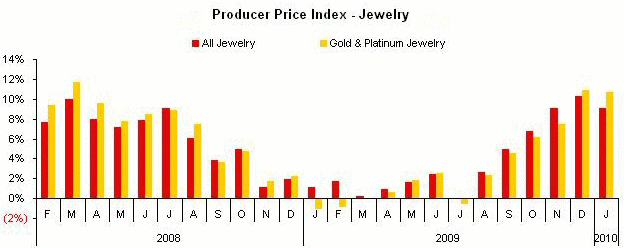IDEX Online Research: Jewelry Price Inflation Slows in January (Full Report)
March 02, 10
While the good news is that jewelry price inflation moderated at both the producer and retail level in January, the bad news is that margins continue to be squeezed tighter throughout the jewelry supply chain.
Retailers have been unable to pass along higher jewelry prices to value-seeking shoppers. As a result, merchants’ margins are under siege. Further back in the supply chain, producers’ and wholesalers’ margins are also under assault since their costs are soaring, but they are not able to pass along the bulk of those increased costs to their retail jewelry store operators.
We believe that there are three factors that helped moderate jewelry price inflation during January:
· Lack of seasonal demand – After coming off the all-important November-December 2009 holiday selling season, there is no major event in January driving demand. While Valentine’s Day is the second most important selling period during the year for jewelers, most merchants had already placed their orders late last fall. Despite very strong jewelry demand at the end of 2009, jewelers still have not begun re-stocking with vigor.
· Stable commodity prices – In particular, gold prices appear to have moderated very modestly in the past sixty days. This has taken some of the pressure off gold jewelry producers to raise prices.
· Relatively stable currency exchange rates – During January, currency valuations were generally stable versus the U.S. dollar. Thus, currency fluctuations had a minimal impact on prices. In 2009, the U.S. dollar weakened against many other currencies, thus introducing inflationary pressure to jewelry prices, especially for goods produced overseas.
January Jewelry Inflation Moderates At Producer Level
During January 2010, jewelry price inflation was up 9.1 percent at the producer level on a year-to-year basis, as measured by the Jewelry Producer Price Index. While this is a very high level of inflation, it represents a decline from the 10.8 percent inflation rate recorded in December 2009.
The following graph illustrates the monthly inflation rate at the jewelry producer level for the past two years. It is clear that inflation surged at the producer level during the last four months of 2009, after remaining relatively calm earlier in 2009. However, in January 2010, jewelry producer price inflation moderated.
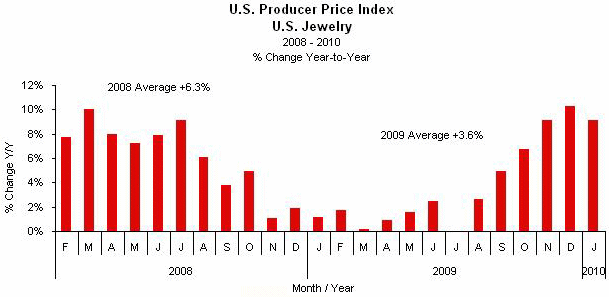 Source: BLS |
On an underlying basis, precious metal jewelry – primarily gold merchandise – showed greater inflation at the producer level than all jewelry. Total jewelry price inflation at the wholesale level was up 9.1 percent in January; price inflation for gold and platinum jewelry rose by 10.7 percent.
The graph below compares price inflation trends for all jewelry versus precious metal jewelry by month for the trailing twenty-four months. After being relatively tame earlier in 2009, wholesale prices of precious metals jewelry began to rise sharply in the fourth quarter, peaking in December 2009.
|
|
Watch Price Inflation Moderate At Producer Level in January
While jewelry price inflation has been on a roller coaster ride over the past few months, watch price inflation has been relatively stable. Further, there has been very little inflation at the producer level for watches. Fine watch prices were up a very modest 1.7 percent at the producer level during the month of January. Unfortunately, demand for watches has remained weak; thus, watch producers have little or no pricing power.
The graph below illustrates month-by-month price inflation trends for fine watches at the producer level during the past twenty-four months.
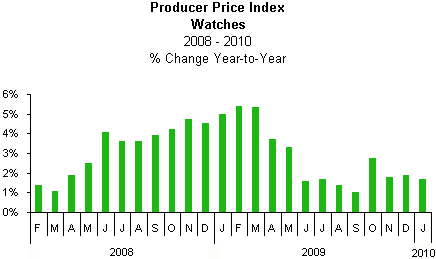 Source: BLS |
Jewelry Retail Price Inflation Modest in January
During January 2010, retail prices for jewelry and watches rose by a very modest 0.8 percent, a sharp decline from December, and a rate that was about half of the inflation rate for the full year 2009.
The graph below illustrates monthly retail jewelry price inflation for the past two years.
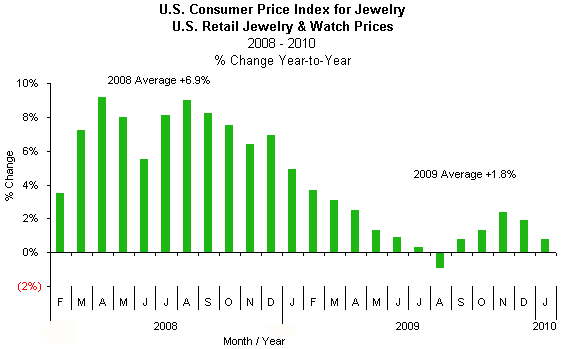 Source: BLS |
Underlying Components of JCPI Relatively Stable in January
Jewelry prices were up 1.1 percent, while watch prices at retail fell by 1.4 percent during the month of January 2010, when compared to the same month in 2009. The decline in fine watch prices is no surprise, since watch prices at the producer level showed little movement. Watches showed price deflation at the retail level for virtually every month during the second half of 2009.
In contrast, retail prices of jewelry moved higher in the final half of 2009, driven largely by higher precious metals prices, though retail price inflation for jewelry moderated during December and January.
The graph below compares the overall inflation rate for jewelry and watches by month to each of the component inflation rates – jewelry and watches separately.
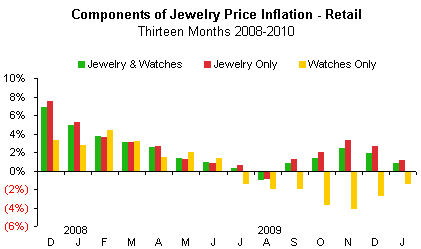 Source: BLS |
Jewelry Producer Inflation Rates Outstrip Retail Jewelry Inflation Rates During Second Half of 2009
The margin squeeze is real: jewelry producer prices have risen dramatically faster than retail jewelry prices during the final half of 2009 and into 2010.
The graph below compares retail jewelry prices and producer jewelry prices on a monthly basis for the trailing twelve months.
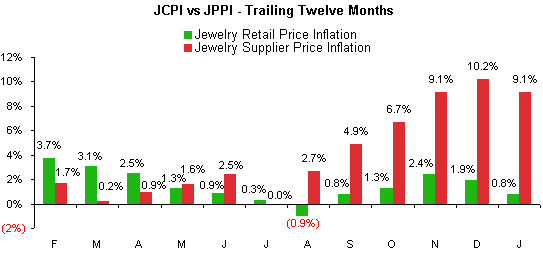 Source: BLS |
Outlook: Retail Jewelry Prices Are Headed Higher; Watch Price Inflation Less Likely
With the stock market up, but uncertain, and with the housing market bouncing along the bottom, investors and consumers are looking at hard assets that may hold their value. They have clearly turned their attention to precious metals, and their buying has pushed prices up sharply over the past year.
Further, as strengthening jewelry demand has translated into improved jewelry sales for retailers, there is some likelihood that merchants will re-price goods upward this year. The graph below compares the Jewelry Consumer Price Index to Total Jewelry Sales trends (monthly percent change year-over-year) during 2009. When jewelry sales were extremely weak, jewelry prices moderated. As jewelry sales have perked up, inflation has returned to the industry.
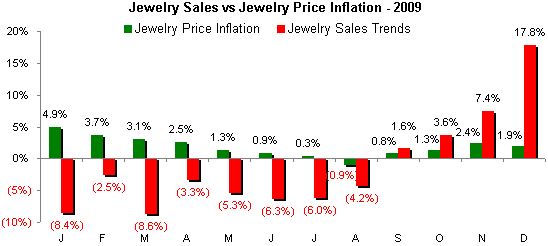 Source: BLS |
The only good news is that the retail prices of lower price-point merchandise probably won’t rise as quickly has more expensive goods. The largest cost component of lower price-point merchandise – under $300 at retail – is labor. Globally, currencies have been stable, and there is some indication that the U.S. dollar may be strengthening.
However, jewelry merchandise priced at $1,000 and above retail is likely to rise more sharply in price since the costs of both the precious metals and precious gemstones are the largest cost component of the goods.
While precious metal prices have stabilized, polished diamond prices are on the rise. While it takes about a year for diamond jewelry inventory to turn at the retail level, new goods coming into a retail store will necessarily be priced higher than existing goods in inventory, simply to reflect the rising cost of diamonds.
It is difficult to forecast watch prices. Luxury buyers have been on holiday for the past two years, but appear to be returning to the market. However, more consumers have forsaken their watches in favor of checking the time with their mobile phones, computers, and other electronic gadgets.
